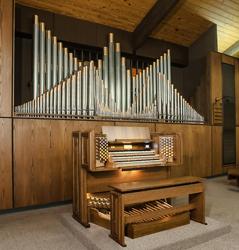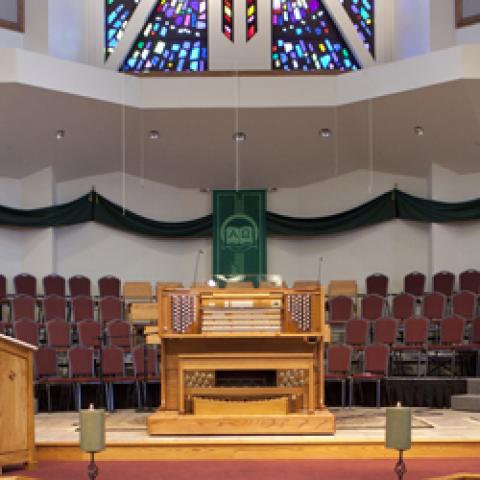James B. Hartman
Organ enthusiasts who wish to learn about organs far outside their immediate vicinity have at their disposal a number of search engines to survey the Internet, such as Alta Vista, Google, InfoSeek, Lycos, WebCrawler, and Yahoo; however, these are neither easy nor efficient for this purpose. A particularly effective source is offered by the Dutch magazine, het ORGEL (the ORGAN), a publication of Koninklijke Nederlandse Organistenvereniging (KNOV, i.e., Royal Dutch Organists Association); this is Europe’s oldest magazine on organ art: <www.hetorgel.nl>.
The organ links of het ORGEL are in three categories: Countries, Related Instruments (Carillons, Barrel Organs, Harmoniums, Theater Organs, Harpsichords), and General Information (General, Composers, Liturgies, Music Software, Organists Societies, Organ Music).
There are links to organ sites in 65 countries throughout the world: Algeria, Argentina, Australia, Austria, Azerbaijan, Barbados, Belgium, Bolivia, Bosnia, Brazil, Bulgaria, Canada, Chile, China, Colombia, Croatia, Czech Republic, Denmark, Ecuador, England, Estonia, Finland, France, Germany, Greece, Guatemala, Hungary, Iceland, Indonesia, Ireland, Isle of Man, Israel, Italy, Jamaica, Japan, Korea, Latvia, Liechtenstein, Lithuania, Luxembourg, Malaysia, Malta, Mexico, Moldavia, Netherlands, New Zealand, Norway, Philippines, Poland, Portugal, Romania, Russia, Scotland, Singapore, Slovakia, Slovenia, South Africa, Spain, Sweden, Switzerland, Tanzania, Ukraine, Uruguay, U.S.A., and Zambia.
The relevant information in each country is classified under six headings: General, Organ Builders, Persons, Churches and Concert Rooms, Conservatories/Music Schools/Universities, and CDs/Books. The form of the entries in the different countries remains largely the same throughout but with local content appropriate to the particular country. Many sites include photographs of organ pipe façades and consoles.
An overview of the Web sites of several selected countries follows (some locations have more than one Web site).
U.S.A. The General category, with 147 entries, includes the Web sites of the chapters of the American Guild of Organists, along with a listing of other miscellaneous organizations, societies, topics, and publishers (including The Diapason). It also contains a Web site devoted to the largest pipe organs in the world, but this matter is not easily resolved due to some debatable technical distinctions.1
In the Organ Builders category there are 175 Web sites, including those of such well-known manufacturers as Aeolian-Skinner, Fisk, Holtkamp, Keates-Geisler, Möller, Reuter, Schlicker, and Wicks.
Under Persons the 187 Web sites include familiar names of many organists and concert artists: E. Power Biggs (1906-1977)2, Virgil Fox (1912-1980)3, Edwin H. Lemare (1865-1934)4, Rosalyn Tureck (1914-2003)5, and others. A typical site in this category includes a biography, a résumé, church appointments, compositions, repertoire, concerts, tours, recordings, a discography, testimonials, reviews, writings, links to related sources, and sometimes audio clips.
The Churches and Concert Rooms category consists of an alphabetical list of 614 locations throughout the country. New York City has 23 sites, including Alice Tully Hall in Lincoln Center, as well as Riverside, St. John the Divine, and St. Thomas churches, among many others.
There are 94 Universities and Music Schools, including Indiana University School of Music, New England Conservatory of Music, Oberlin Conservatory of Music, Peabody Conservatory, and schools at many state universities.
In the CDs and Notes category there are 98 Web sites of music publishers, bookstores, catalogs, record companies, and music societies.
A small category, Music Programs, consists of nine sites, including a software distributor and other sources.
Canada. The General category, with 33 entries, consists of the Web sites of 13 local chapters of the Royal Canadian College of Organists, two branches of the Royal School of Church Music, and the sites of other organizations, societies, publishers, festivals, and miscellaneous topics. A particularly ambitious Web site, Organs of the United States and Canada Database, is intended to provide a single, consistent, accessible, historical source of the organs constructed or installed in the United States and Canada since the arrival of the first imported instrument in the colonies; this listing of about 90,000 instruments and 1,800 builders is accessible only by inquiry to the site originator in Seattle, Washington.
In the Organ Builders category there are 26 sites, including Canada’s leading builder, Casavant (three sites), along with other prominent firms like Guilbault-Thérien, Keates-Geissler, Létourneau, Wilhelm, and Wolff.
Under Persons 29 organists have Web sites; there is a historic entry for the Lynnwood Farnam (1885-1930) Society. A separate listing of Organists in Québec is also provided.
The Churches and Music Rooms category includes information on 70 locations in major cities across the country. A relatively new organ is the Davis Concert Organ, four manuals, 96 stops, in the Francis Winspear Music Centre in Edmonton, Alberta, installed in 2002 by Orgues Létourneau, Saint-Hyacinthe, Québec.
In the category of Universities/Music Schools six are identified, all in eastern provinces.
Under CDs and Books there are seven publishers or distributors.
England. The General category, with 58 entries, includes the Web sites of organizations such as the Guild of Church Musicians, Royal College of Organists, Royal Society of British Organists, along with associations and societies in various cities, and other specialized organizations. Several magazines or other publications devoted to the organ or organists are also listed here.
In the Organ Builders category there are 39 names, including the Incorporated Society of Organ Builders, Harrison & Harrison, N. P. Mander, and Henry Willis & Sons.
Under Persons 68 organists are listed, including such notable players as David Briggs, Sir Peter Maxwell Davies, Christopher Herrick, John Stainer (1840-1901), Gillian Weir, Carol Williams, and Arthur Wills.
The Churches and Concert Rooms category consists of 290 locations in major centers throughout the country, some in universities such as Cambridge, and others in cathedrals such as Coventry, Durham, Exeter, Gloucester, Leicester, and Liverpool. Royal Festival Hall, St. George’s Chapel in Windsor Castle, and Westminster Abbey are also found here.
In the category of Music Schools there are 12 sites, including the Royal Academy of Music, Royal College of Music, Royal School of Church Music, and similar academies connected with educational institutions.
Under CDs and Books there are 43 Web sites of music publishers, bookstores, catalogs, record companies, and music societies.
France. The General category, with 79 entries, includes the Web sites of associations and societies--”Les Amis de l’Orgue”--in various cities, reports of organ festivals and seminars, and miscellaneous topics, such as French Organ Music and pages devoted to organ magazines.
In the Organ Builders category there are 49 sites, a few with historical significance: Jean-André [Johann-Andreas] Silbermann (1678-1734), Aristide Cavaillé-Coll (1811-99), and Dom Bédos de Celles, L’Art du Facteur d’Orgues, in addition to present-day firms and the comprehensive Groupement Professionnel des Facteurs d’Orgues.
Under Persons 48 names are listed, including such familiar figures as Pierre Cochereau (1924-1984), Jean Guillou, Naji Hakim, Jean Langlais (1907-1991), André Marchal, Daniel Roth, and René Saorgin; there is a separate site for Parisian Organists that lists the organists who served at churches in Paris from the 13th to the 21st centuries.
The Churches category covers 414 establishments in the major cities. Paris includes Notre Dame, Sacré-Coeur, St. Eustache, St. Sulpice, St. Clotilde, St. Gervais, and Madeleine, all familiar on account of their associations with famous organists of the past; there is a separate site for organs of Paris. In the category of Schools, there are only three, led by the Conservatoire de Paris.
Under CDs, Books, and Sheet Music, there are 25 Web sites of music publishers, suppliers of music publications, and record companies.
Germany. In the Organ Builders category there are 234 names, some of which may be familiar to North Americans: von Beckerath, Gabler (1700-1771), Glatter-Götz, Klais, Laukhuff, Schnitger, Silbermann, and Walcker. Here, as in some other countries, there is a comprehensive Web site devoted to organ building; a number of entries are related to historic builders of the 18th and 19th centuries.
Entries in other categories--General, Persons, Churches, Conservatories, CDs and Books--are appropriate to Germany.
Australia. The General category has 10 Web sites that include several societies, including a branch of the Royal School of Church Music, England.
There are only two Organ Builders in the country; both are small firms that construct small organs and provide restoration and maintenance services.
In the Churches/Concert Halls category there are 51 Web sites. These reveal that several town halls have organs: Adelaide, Melbourne, Perth, and Sydney. The activity of external makers is evident in the case of Melbourne, where the five-manual Hill, Norman & Beard instrument, acquired in 1929, was rebuilt by Schantz, U.S.A., commencing in 1999. A special Web site, Second Wind, reports that elegant furniture was made from timbers taken from the Melbourne Town Hall organ when it was renovated in 2001. A monastery library in Arcadia also has an English organ by T. Atterton: two manuals, 11 stops, 1893, later restored in Melbourne.
In the Schools category there are six sites, one for the Sydney Conservatorium of Music, the others connected with the music faculties of the major universities.
South Africa. The General category has five Web sites, including one of the Johannesburg Organ Society, which promotes all aspects of the organ, including recitals, workshops, concerts, and visits to significant instruments.
There are only two firms listed in the Organ Builders category, specializing chiefly in the restoration, rebuilding, and maintenance of existing instruments.
In the Churches category there are eight entries. One of these, St. George’s Cathedral in Cape Town, has an organ that originally was in St. Margaret’s Church in London, England (next to Westminster Abbey). In 1909 a later four-manual, 61-stop organ was donated to St. George’s by a London businessman who had connections in South Africa. The largest organ in the country is in Feather Market Hall, Port Elizabeth, with 5,508 pipes.
The two Universities/Music Schools are University of South Africa, and University of Cape Town where the Baxter Concert Hall has a three-manual, 49-stop von Beckerath instrument, inaugurated in September 1977 (von Beckerath died on 20 November 1976 before the installation was completed).
This survey will conclude with a few miscellaneous items concerning organs in several selected countries.
In Denmark the Frobenius firm has completed slightly more than 1,000 organs since it was founded in 1909; of these, five are in England, two in U.S.A., and five in Japan.
Hong Kong, a special administrative region of China, has one organ in the Hong Kong Cultural Center.
In Ireland the Pipe Organ Site, in addition to providing information on organists, organ specifications, organ builders, and recordings, contains a section on organ jokes.6
The Isle of Man Organists Association held an Organ Festival in 2002 that included recitals by Gillian Weir and others, workshops, and a gala dinner (£12 including wine!).
The independent state of Malta, consisting of three islands south of Sicily in the Mediterranean Sea, has seven organ builders and restorers; a recent project was the restoration of the ‘Platania’ organ, originally built in Sicily in 1726.
In The Netherlands two famous organ builders are found among the 42 firms listed: Schnitger (1648-1719) and Flentrop (since 1903). Stinkens, organ pipe makers (since 1914), is also active there.
The Philippines has two old organs, two organ builders, and two churches; it recently held its 29th International Bamboo Organ Festival.
In Zambia, an independent country (formerly called Northern Rhodesia) in east central Africa, the Cathedral of the Holy Cross in Lusaka has a two-manual, 25-stop organ (builder not identified). In addition to containing information on the organ, the church’s Web page contains sermons, anniversaries, church news, prayer requests, and other information of interest to the parishioners.
The immense amount of organ information contained in the worldwide Web sites defies even a summary description. Given the diversity of languages among the different countries, not all of this information is easily available to English-only readers for that reason, although some sites provide an English version in addition to the language of the country of origin. On the other hand, it is possible to recognize the stop names of organs in most cases on account of their widespread similarity throughout the world. The curious reader can only speculate on the vast number of organs in these countries that do not have Web sites! Visiting the various Web sites, with their colorful and attractive home pages, also provides aesthetic experiences of diverse organ designs. The reader will discover that some Web sites are unavailable or have moved; many are church pages, where the organ is included but is secondary in importance.
KNOV’s assembly of Web sites provides a valuable cultural resource that will be useful for a variety of purposes: recreational exploration of the world of the organ on the Internet, comparative research on organ specifications and the historical backgrounds of the instruments, and perhaps for planning future journeys to the countries where existing organs can be found, inspected, and perhaps played.




